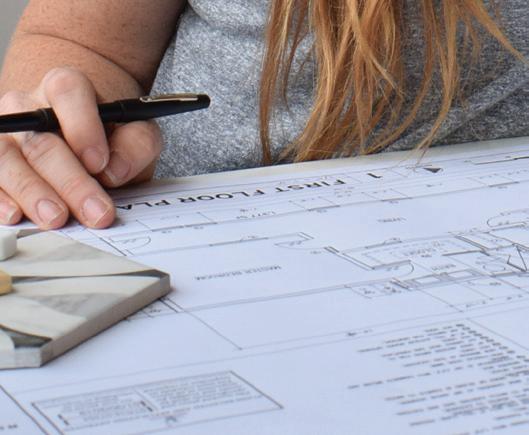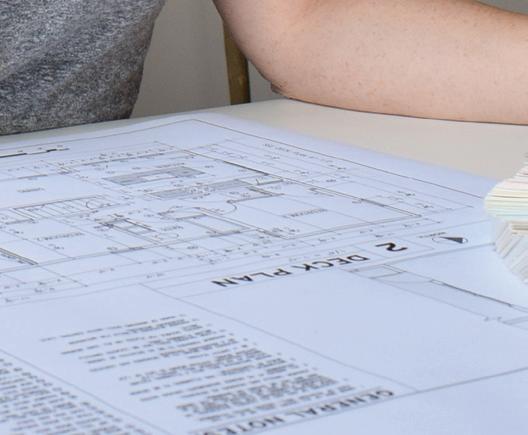



MINA STARSIAK HAWK
The HGTV star shares her cost-effective tips for elevating rental property value and appeal





The HGTV star shares her cost-effective tips for elevating rental property value and appeal

“Every property will have problems, but how they are handled will make a world of difference.”



“The leasing process is becoming increasingly automated, from inquiry to approval to move-in.”


Rental fraud is quietly costing landlords millions, and even thorough background checks aren’t always enough to catch it.
The 2023-24 Pulse Survey conducted by the National Multifamily Housing Council (NMHC) found that over 70% of major apartment landlords reported an increase in fraudulent activity in the past year. They also reported that application fraud has nearly doubled since before the pandemic.
Adding to the challenge, it’s becoming harder for landlords to learn about an applicant’s criminal or eviction history. In 2023, Alameda County in California became the first in the United States to ban criminal background checks for renters, kickstarting a national trend to restrict access to criminal records.
What’s more, since 2017, the three major credit bureaus have removed civil judgments and state and federal tax liens from credit reports. That means a renter with an eviction record may still have a strong credit score, unless a landlord has won a monetary
judgment and reported it through a collection agency.
With access to data diminishing and applicant fraud increasing, there are some precautions landlords should be taking to ensure they rent to good tenants.
Rental fraud takes many forms
As with most crime, rental fraud takes many shapes while it continues to evolve; 84.3% of the survey respondents reported seeing applicants falsifying or fabricating pay stubs, employment references, or other income documentation.
The following are the most common application frauds at this time:
• Identity theft: Scammers steal personal information, including Social Security numbers, to create false identities to apply for a lease.
• Providing fake credit reports: Applicants provide a falsified credit report with a high score and an exaggerated record of on-time payments.

• False financial information: Tenants will provide a fake employment history and ask friends or family to pose as employers to verify employment.
• Paying for rent and security deposits with fake checks: Tenants using fake check scams will provide fraudulent checks for rent, security, or a deposit to gain access to the unit without the intention of legitimately paying.
Combatting rental fraud
Armed with the tools they need to address fraud head-on, landlords and property managers can outsmart the scammers using these simple steps:
• Confirm income by asking for documentation, such as bank statements, income statements, and tax returns.
• Conduct landlord and employment verification.
• Landlords should order a civil judgments and tax liens report,
since that information has been removed from credit reports.
• Landlords need to run a Social Security number fraud report to determine if their applicant is using their own number or that of someone else, even a deceased person.
• A written set of criteria should be given to every applicant to guard against litigious scammers.
• Ask your tenant screening provider if they have access to county criminal records.
Utilizing these steps to strengthen their defenses, rental property owners can win the battle against unlawful fraudsters and scammers.






A new property management tool is streamlining tasks like tracking properties and tenants, managing rental agreements and maintenance requests, and collecting rent, simplifying the process for both landlords and tenants.


TurboTenant offers software solutions to help rental property owners efficiently operate rental businesses. The company helps more than 850,000 landlords in the United States by providing tools like property marketing, rental applications, tenant screening, online rent collection, maintenance.
Landlords can access TurboTenant online or through an app. The service is free, but users can upgrade to unlock additional features.
“We’re talking to everyday investors that are just trying to be more successful,” said Harrison Stevens, vice president of marketing for TurboTenant. “We’re giving them the best tools to reach their goals, and we’re saving them thousands of dollars a year compared to what a property manager would charge them.”
Census data shows that of the nearly 20 million rental properties in the United States, the majority are owned by individual investors, with more than 14 million people owning one to four properties.
Property owners may feel overwhelmed and decide to hire a property manager to handle the rental process, but TurboTenant empowers owners to manage their rental properties efficiently on their own.






“If you have one property, you don’t need a property manager,” Stevens said. “If you have 10 properties, you don’t need a property manager. If you have 50 properties, you don’t need a property manager. With the right tools and support, I have seen thousands of landlords succeed.”
TurboTenant helps landlords find tenants with free, one-click listings. Plus, it can help them run background checks, navigate leases and down payments. It also assists with understanding the nuances of real estate markets, including local laws. For example, local governments set different rules for how much you can charge for a pet or a security deposit, and TurboTenant can help property owners set these amounts.
First-time landlord Jillian Emura praises TurboTenant, saying it “has made being a landlord just really easy.” Part of the reason for that is that TurboTenant is a one-stop service.
“It really has everything that we have needed,” she said. “We were able to create our lease through it, and we had no idea how to create a lease.”
Emura’s favorite feature of TurboTenant is the payment function. Her tenants can pay online, and she can easily track these payments. The software can automatically add a late fee for past-due rent.












“If our tenant doesn’t make a payment on time, we get notified that they haven’t made the payment, and then they also get nudged that they haven’t made the payment,” she said.
Creating great experiences
TurboTenant is constantly improving — it’s now using AI to enhance the user experience. Soon, the software will be able to offer guidance to renters who have maintenance questions, potentially helping renters resolve their issue before their landlord needs to call a repair person. Plus, landlords can digitize move-in and move-out walkthroughs, reducing stress and miscommunication when it comes to tenants getting deposits back.
“We are trying to make being a landlord feel more like being a host, and reminding them that tenants are their customers,” Stevens said. “We are changing the way that people look at landlords, by providing them with industry-leading tools to make them more successful.”
“The landlords we service are everyday people, trying to build a successful investment strategy, and with TurboTenant they can do it in a professional way to lead to the highest chance of success. These are everyday people that now have the tools to create great experiences.”
Written by Kristen Castillo








Mina Starsiak Hawk, co-founder of Two Chicks and a Hammer, shares practical tips on
From a renovation and home improvement perspective, what are the top features that make a rental property more appealing to tenants?
Updated kitchens and bathrooms with modern fixtures are always a draw, as are durable, easy-tomaintain flooring options like luxury vinyl plank instead of carpet. Energy-efficient appliances and smart home features, such as thermostats and keyless entry, are increasingly important to renters. Ample storage solutions, including closets, built-ins, and pantry space, make a big difference in day-to-day living. Fresh, neutral paint colors help create broad appeal, while in-unit washer/dryer or hookups are highly valued. Outdoor spaces, even small patios or balconies, also add significant appeal to a rental property.
For landlords on a budget, what are some high-impact, low-cost upgrades that can increase rental value?
Fresh paint in modern, neutral tones is one of the most cost-effective ways to refresh a space. Replacing outdated cabinet hardware and light fixtures can quickly modernize the look of a property. Curb appeal improvements like deep cleaning and minor landscaping can leave a strong first impression. Instead of replacing countertops, refinishing



or resurfacing them is an affordable alternative. Updating faucets and showerheads gives kitchens and bathrooms a fresh look, while adding or upgrading window treatments provides a more polished finish.
With sustainability becoming a bigger priority, what eco-friendly renovations



or upgrades would you recommend for rental properties?
Installing LED lighting and energy-efficient appliances is a great place to start. Low-flow toilets and faucets help reduce water waste, while smart thermostats improve energy efficiency. Proper insulation and weatherstripping keep energy bills down for
tenants and owners alike. Using VOC-free paint also supports healthier indoor air quality, which tenants will appreciate.
What advice would you give landlords on maintaining good relationships with tenants while balancing necessary renovations and upkeep?
Being proactive with maintenance and responding quickly to repair requests is key. Open communication about upcoming renovations or changes helps build trust and keeps tenants informed. Offering incentives for long-term tenants, such as small upgrades or rent discounts for timely payments, can also encourage loyalty. Respecting tenant privacy and providing ample notice before entering the property is essential, and maintaining a fair, professional, and approachable relationship goes a long way in creating positive landlord-tenant dynamics.
If you could give one piece of advice to property managers looking to add long-term value to their rental homes, what would it be?
Invest in quality materials and regular maintenance. Cutting corners often leads to bigger expenses down the road, while well-maintained properties not only attract responsible tenants but also retain value over time.
Three major themes are influencing rental housing prospects this year: rental shortages, post-pandemic lessons, and regional migrations. Considering these will help you more easily navigate finding your next rental.
Three major themes are influencing rental housing prospects this year.
The first of these is a legacy problem: building too few rental properties over the past decade. The shortage of new rentals has resulted in a demand that cannot be met, forcing prices higher. At the same time, many single-family housing rental properties are being sold to owner-occupants as market prices have also jumped higher.
With increasing construction costs on everything from lumber to logistics to, of course, workers — when they can be hired — new rental property development is facing the double jeopardy of tighter credit financing and longer development processes due to numerous NIMBY (“Not In My Back Yard”) anti-development efforts. All of these constraints mean new developments are unlikely to relieve pricing pressure until demographic factors, such as the smaller and smaller generational bumps of Gen Z and following, begin rolling through in the next couple of years.
The second key influence has been the lessons learned from the pandemic. Roommates wanted more space (and fewer roommates) and were willing to pay for it. Urban areas felt the impact of work-from-home efforts, as those

Hence, a traditional one-bedroom occupant will now rent a two-bedroom unit, utilizing the second room as an office. This spreading out continues to support higher occupancy rates.
All of these constraints mean new developments are unlikely to relieve pricing pressure ...
who could work from home were more willing and able to secure their own larger rental space.
The third major influence has a more regional impact, as migrations toward Southern cities have grown substantially. The influx of northerners to cities like Orlando and Dallas has steadily increased, with U-Haul statistics reflecting the migration. Additionally, with work-from-home and tax fatigue growing, some high-tax areas like the Northeast and California have seen an exodus of residents choosing to relocate to more
rural areas and those that are less wallet-burdening.
Some of the more personal concerns for those seeking rental options are the variety of choices in amenities and even the size of a complex in which to live. While many larger buildings will offer more amenities, the privacy and community aspects can be more complicated, or even non-existent. Beyond just the monthly rental price, asking about additional fees — monthly, yearly, and per-use — as well as the utility costs, can provide a better perspective on the real cost of the rental.
Finally, when considering your next rental home, be sure to investigate the responsiveness of the property owner and staff. Are there systems in place for handling emergencies? Is the housing provider local or an out-of-town, faceless, and semi-nameless corporate entity with limited accountability? Every property will have problems, but how they are handled will make a world of difference.

WRITTEN BY Charles Tassell
Fast EV charging is the new luxury — and necessary — amenity for multi-unit residential buildings.

Fast electric vehicle (EV) charging has rapidly become one of the most requested amenities for multi-unit residential buildings. As EV adoption rises, large residential developments must accommodate the EV charging needs of their tenants. To this end, realtors, developers, property owners, and property managers are quickly integrating chargers into existing and future projects.
Easier said than done
Adding EV charging to an existing building can be a complicated process. While the U.S. Department of Energy reports that more than 80% of EV charging occurs at
home, the charging landscape at a condo or apartment complex is much more complicated than in single-family homes or small multi-unit dwellings. I know this from firsthand experience.
The property I manage is a 470unit luxury high-rise condominium complex in Florida, and some tenants started driving EVs when the complex opened 10 years ago. To support these EV drivers, we installed six Level 2 chargers to meet the residents’ needs.
With the Level 2 chargers, charging a vehicle is slow going, as they deliver approximately 10 to 25 miles per charging hour. Most residents left their EVs to charge overnight. In the beginning, this
was fine. However, by early 2022, it was clear that the Level 2 chargers could no longer support the needs of residents. We needed to explore alternatives.
We were leaning toward directto-grid Level 3 fast charging when one resident introduced us to a new technology called battery-buffered, ultra-fast EV charging. The approach is ideal for existing buildings as it requires virtually no additional construction. Although it draws from our existing on-site electrical capacity, the system can charge a vehicle in approximately 20–30 minutes, equally as fast as direct-to-grid
Level 3 chargers, which would require a major electrical upgrade and significant construction. We ultimately decided to install two battery-buffered ADS-TEC Energy ChargeBox systems.
After the system was installed, we ensured that the residents were aware of it and the steps they needed to take to use it. Those who choose to use it pay an annual fee plus a per kW usage fee and are given access to a smartphone app and an RFID card to activate the system. We also trained our frontdesk reception, valet parking, security, and building management staff on the system so they could assist residents as needed. Several months into the deployment, the rave reviews started rolling in. Residents could not believe how quickly and easily they could fully charge their EVs. While public EV chargers are great, they are no substitute for the convenience of “filling up” at home. Residents are using the ultra-fast system similarly to the way they use a traditional gas station: They come in, plug in for 10–15 minutes, and are ready for the next day.
This article was originally published in the March/April issue of Journal of Property Management. Read the full article at jpmonline. org/ultra-fast-and-in-demand/.

WRITTEN BY George Barriere CEO, Vicky Bakery; Former Regional Director,
Anthony Melchiorri, host of “Hotel Impossible,” shares practical strategies and operational tips to elevate rental experiences and maximize long-term profitability.
What are the key principles landlords and property managers can take from the hotel industry to create better rental experiences?
Surprise and delight are powerful. However, surprises should never come at the expense of comfort. The basics matter most: a comfortable bed, working plumbing, hot water, easy-to-use fixtures, and a spotless environment. Once basic needs are consistently met, then it’s okay to get creative and add personality.
Many landlords want to scale their businesses but struggle with operations and guest experience. What are some best practices to improve efficiency and maximize profitability?
There’s no shortcut; it comes down to fundamentals. First, know your local laws before you ever invest. Second, hire a great lawyer. Third, understand operations. Running rentals is no different from running a hotel, a restaurant, or even a candy store. Success comes from sound business practices, not quick wins.
What tech tools or innovations do you see as game changers for rental owners?
Smart locks and revenue management systems are already game changers, but the next big leap is in AI-powered analysis. Owners can now track guest behavior — how long people spend on their website, which photos they view, how quickly they book — and use that data to improve marketing, pricing, and operations.
What’s one piece of advice you’d give to a property owner who is looking to revamp and optimize their rental business?
Care about your employees and your guests more than your bottom line. If you do that, the bottom line will take care of itself.

Steve Weikal, a researcher focused on new technologies in real estate, discusses how AI, digital platforms, and tenant engagement tools are transforming rental experiences.
You’ve dedicated your career to exploring how technology is transforming real estate. What do you see as the biggest disruption currently reshaping the rental market?
The leasing process is becoming increasingly automated, from inquiry to approval to move-in. Some properties already have “self-serve” leasing offices and property tours. This experience will become even more common as agentic AI gains traction.
Digital platforms have changed how we search for, apply to, and manage rentals. What’s next in the evolution
of digital renting, and how do we ensure that renters aren’t left behind due to digital literacy or access gaps?
Recent research from my colleagues at MIT Sloan shows that people with less experience gain the most from generative AI. These new tools will increase digital literacy and narrow access gaps, leveling the playing field for all renters.
What do you see as the greatest opportunity for real estate technology to improve the renterlandlord relationship in ways that build trust and long-term stability? Tenant engagement technology enables a valuable feedback loop for building
managers and tenants to collaborate on achieving shared sustainability goals, better property operations, and reducing monthly costs.
Looking ahead, what does the future of renting in America look like to you, and what role should property technology play in creating a more inclusive, resilient, and humancentered rental ecosystem?
Technology continues to make real estate more responsive to stakeholder needs — both tenants and landlords — allowing a more integrated, flexible, user-focused experience.

